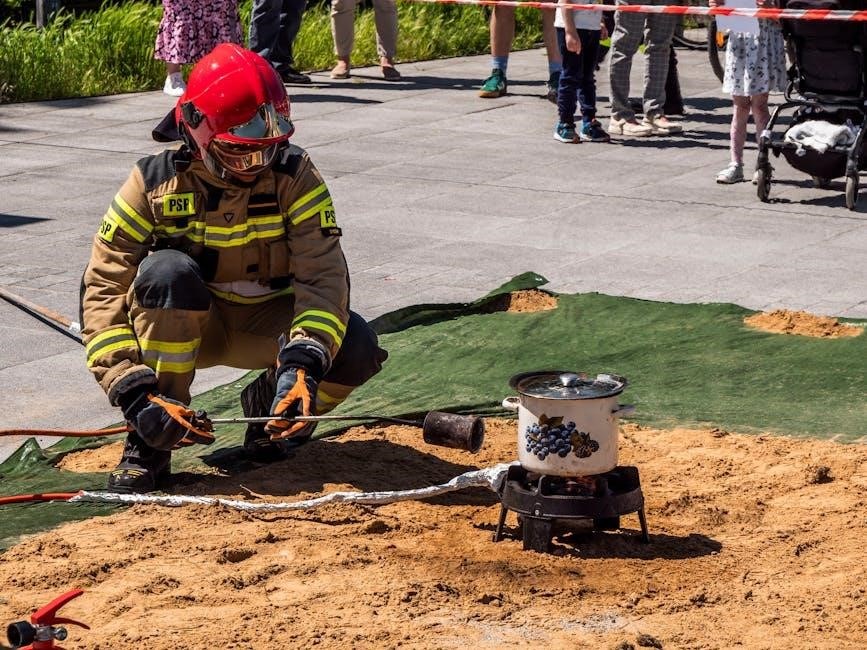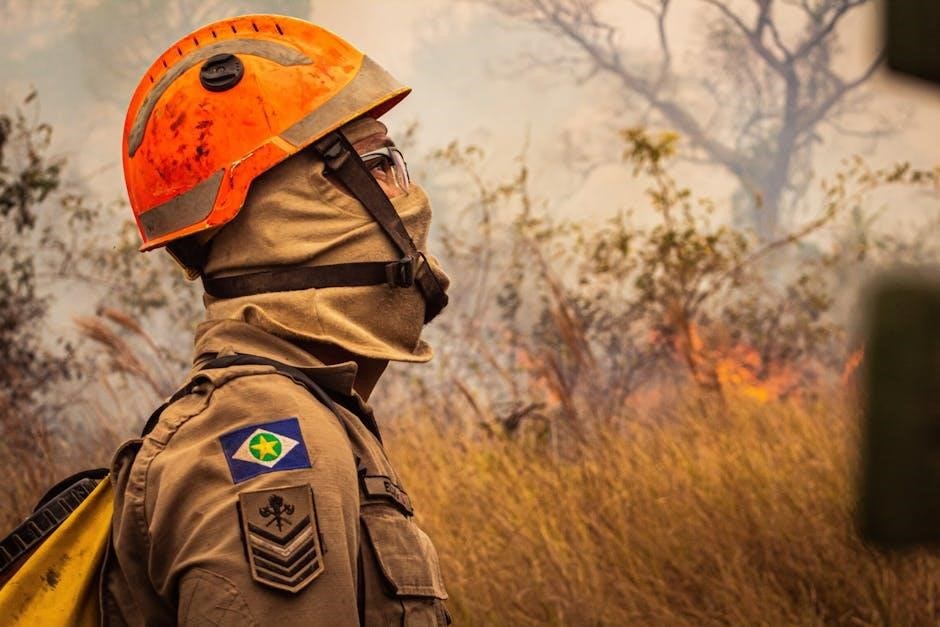This workbook serves as a comprehensive guide for mastering firefighting skills, focusing on safety, equipment, and tactical procedures. It includes practice exercises and skill drills to enhance learning and retention.
1.1 Overview of the Fundamentals of Firefighter Skills 4th Edition
The Fundamentals of Firefighter Skills 4th Edition provides a detailed framework for mastering essential firefighting techniques. It covers foundational topics such as fire dynamics, personal protective equipment, and emergency procedures. The workbook includes practical exercises, skill drills, and real-world case studies to reinforce learning. Key areas like fire behavior, safety protocols, and rescue operations are thoroughly explored. For instance, Skill Drill 14-5 focuses on conducting a fire hydrant flow test, ensuring hands-on understanding. The content is structured to align with modern firefighting standards, making it an invaluable resource for both students and instructors. The 4th edition emphasizes critical thinking and adaptability, preparing firefighters for diverse emergency scenarios. By integrating theory with practice, this workbook ensures a comprehensive understanding of firefighting principles and their practical application.
1.2 Importance of the Workbook in Firefighter Training
The workbook is an essential tool in firefighter training, offering structured exercises to reinforce theoretical knowledge. It provides a practical approach to mastering firefighting skills, ensuring students are well-prepared for real-world scenarios. The inclusion of an answer key allows for self-assessment, enhancing understanding and retention of critical concepts. By focusing on key areas such as fire behavior, safety protocols, and equipment usage, the workbook bridges the gap between classroom learning and on-the-job application. Its comprehensive structure ensures that firefighters develop the necessary competencies to perform effectively in emergency situations. The workbook’s emphasis on hands-on learning and real-world applications makes it a vital resource for both novice and experienced firefighters, contributing significantly to their professional development and operational readiness.
1.3 Structure and Content of the Workbook
The workbook is organized into clear, logical sections, each focusing on specific aspects of firefighting training. It begins with foundational concepts, such as the history and orientation of the fire service, before progressing to critical topics like firefighter safety, personal protective equipment, and emergency procedures. Practical skill drills, such as the fire hydrant flow test, are included to reinforce hands-on learning. The workbook also features review exercises, quizzes, and a test bank to assess understanding and retention of key concepts. Additional resources, including case studies and real-world applications, provide learners with practical insights. The answer key offers detailed explanations, enabling students to verify their responses and identify areas for improvement. This structured approach ensures a comprehensive and effective learning experience, catering to both novice and experienced firefighters.

Key Concepts and Fundamentals

This section covers essential firefighting principles, including fire behavior, safety protocols, and the use of personal protective equipment. It emphasizes emergency communication and incident command strategies.
2.1 Chapter 1: Orientation and History of the Fire Service
This chapter introduces the foundational aspects of the fire service, tracing its historical development and evolution over time. It explores the role of firefighters, their responsibilities, and the core values that define the profession. The section emphasizes the importance of understanding the fire service’s origins, from early volunteer brigades to modern professional departments. Key topics include the development of firefighting techniques, the introduction of safety protocols, and the adaptation of equipment to meet contemporary challenges. The chapter also highlights the significance of fire service traditions and their impact on today’s operational practices. By examining the past, this chapter provides a solid understanding of how the fire service has become a critical component of public safety. This foundational knowledge is essential for aspiring firefighters to appreciate the profession’s heritage and its ongoing role in protecting communities.
2.2 Chapter 2: Firefighter Safety and Well-being
This chapter focuses on the critical importance of safety and well-being for firefighters. It covers essential practices to minimize risks, including the use of personal protective equipment (PPE), health monitoring, and stress management. The section emphasizes the role of safety officers in ensuring compliance with protocols and maintaining a safe working environment. Additionally, it addresses mental health, highlighting the impact of traumatic events and the importance of support systems. The chapter also discusses physical fitness, nutrition, and sleep as key components of overall well-being. By prioritizing safety and health, firefighters can perform their duties effectively while protecting themselves and their teams. This chapter provides practical strategies and guidelines to foster a culture of safety and resilience within fire departments, ensuring long-term career sustainability and peak performance.
2.3 Chapter 3: Personal Protective Equipment (PPE)
This chapter provides an in-depth exploration of Personal Protective Equipment (PPE) essential for firefighters. It covers the types of gear, including helmets, coats, pants, gloves, and self-contained breathing apparatus (SCBA), emphasizing their critical role in safeguarding firefighters during emergencies. The section highlights the importance of proper sizing, maintenance, and inspection to ensure PPE effectiveness. Firefighters learn how to don and doff equipment correctly, as well as how to integrate PPE into their daily operations. The chapter also addresses the psychological impact of wearing PPE, fostering confidence and readiness. By mastering PPE use, firefighters can minimize risks and perform their duties safely and effectively in hazardous environments.

Practice Exercises and Skill Drills
This section offers various exercises and drills to reinforce learning, including tests, quizzes, and hands-on skill drills like fire hydrant flow tests, ensuring practical application of firefighting concepts.
3.1 Chapter 1 Test: Orientation and History
This test evaluates understanding of the fire service’s history, structure, and core values. It covers foundational topics such as the origins of firefighting, key historical events, and the role of modern firefighters. The test includes multiple-choice questions, true/false statements, and short-answer prompts to assess knowledge retention. Students are expected to demonstrate familiarity with the fire service’s mission, ethical standards, and organizational frameworks. The answer key provides correct responses and explanations, aiding both students and instructors in identifying areas for improvement. This test serves as a baseline for understanding the fire service’s evolution and its significance in public safety. By mastering this material, firefighters gain a deeper appreciation for the profession’s heritage and its impact on contemporary practices. The test aligns with the workbook’s goal of building a strong knowledge base for future training and real-world application.
3.2 Skill Drill 14-5: Fire Hydrant Flow Test
This skill drill assesses the ability to conduct a fire hydrant flow test, a critical procedure for ensuring water supply reliability during emergencies. Participants must arrange a series of photos in the correct sequence to demonstrate their understanding of the process. The drill covers essential steps, including attaching hoses, opening valves, and measuring flow rates. It evaluates both theoretical knowledge and practical application. The answer key provides detailed explanations for each step, aiding in self-assessment and improvement. This exercise is vital for firefighters to understand hydrant operation and water supply management, ensuring effective fire suppression. By mastering this skill, firefighters can efficiently secure water sources in real-world scenarios, enhancing overall response capabilities and safety. The drill reinforces the importance of precise execution in critical fireground operations.
3.3 Review Exercises and Quizzes
Review exercises and quizzes are integral to reinforcing concepts and assessing understanding. The workbook includes multiple-choice tests, true/false questions, and fill-in-the-blank exercises. These tools cover various chapters, such as fire behavior, safety protocols, and equipment usage. Quizzes are designed to test knowledge retention and application, while exercises focus on practical scenarios. The answer key provides correct responses and explanations, enabling self-assessment. Regular review helps identify areas for improvement, ensuring a solid grasp of firefighting fundamentals. These resources are essential for both students and instructors, promoting active learning and competency development. By engaging with these exercises, firefighters can enhance their skills and preparedness, ultimately improving performance in real emergencies. The structured format allows for systematic progression, making complex topics more approachable and manageable. This method ensures a thorough understanding of critical firefighting principles and practices.

Emergency Procedures and Response
This section covers critical strategies for emergency scenarios, including understanding fire behavior, building construction, and effective incident command systems to ensure safe and efficient response operations.
4.1 Understanding Fire Behavior and Dynamics
Understanding fire behavior and dynamics is crucial for effective firefighting. This section covers the principles of fire behavior, including the fire tetrahedron, stages of fire development, and the impact of ventilation. It also explores fire dynamics, such as heat transfer, flame spread, and smoke movement. By mastering these concepts, firefighters can predict fire behavior, making their operations safer and more efficient. The workbook includes exercises and quizzes to reinforce these principles, ensuring a solid foundation in fire behavior analysis. This knowledge is essential for developing strategic approaches to firefighting and rescue operations, ultimately saving lives and property. The section emphasizes practical application, linking theory to real-world scenarios encountered by firefighters. Through detailed explanations and interactive drills, learners gain the skills to analyze and respond to various fire situations effectively.
4.2 Building Construction and Fire Attack Strategies

Understanding building construction is critical for effective fire attack strategies. This section delves into various types of construction, including wood-frame, steel, and concrete buildings, and their implications for fire spread and structural integrity. It also covers the principles of fire attack, such as offensive and defensive strategies, ventilation techniques, and the use of water supply systems. The workbook emphasizes the importance of adapting tactics based on building design and fire behavior. For instance, engine companies play a key role in securing water sources and deploying handlines, while ladder companies focus on ventilation and rescue operations. The section also explores the tactical use of compartmentalization and resource management to control and extinguish fires efficiently. By mastering these strategies, firefighters can minimize risks and maximize operational effectiveness in diverse fire scenarios.
4.3 Emergency Communication and Incident Command
Effective emergency communication and incident command are vital for coordinating firefighting operations. This section emphasizes the importance of clear and concise communication during emergencies, ensuring all team members understand their roles and responsibilities. It covers tactical communication strategies, including radio protocols and command structures, to maintain order and accountability on the fireground. The workbook also explores the Incident Command System (ICS), a standardized approach to managing emergency responses. Key topics include the role of the incident commander, resource allocation, and decision-making processes under pressure. Practical exercises and case studies illustrate how effective communication and command systems can enhance operational efficiency and safety. By mastering these concepts, firefighters can improve coordination, reduce risks, and achieve better outcomes in emergency situations. The section also highlights the importance of pre-incident planning and post-incident debriefs for continuous improvement.

Advanced Firefighting Topics
This section covers advanced techniques in rescue operations, hazardous materials response, and water supply management. It provides detailed strategies for complex scenarios, emphasizing modern tools and technologies.
5.1 Rescue Operations and Techniques
Rescue operations are critical in firefighting, requiring precision and skill. The workbook details various rescue methods, including two-person carries and chair carries, emphasizing safety and efficiency. It also covers the use of equipment like stretchers and ropes, providing step-by-step guides for different scenarios. Understanding these techniques is vital for firefighters to perform rescues effectively, minimizing risks to both victims and responders. The answer key reinforces these concepts, ensuring a solid grasp of rescue strategies and their practical application. By mastering these skills, firefighters can handle emergencies with confidence and professionalism.
5.2 Hazardous Materials Response and Mitigation
Hazardous materials incidents require specialized knowledge and techniques. The workbook covers identification, containment, and mitigation strategies for various substances. It emphasizes the importance of PPE and communication during operations. The answer key provides detailed explanations of protocols, ensuring firefighters understand how to safely manage these situations. Practical exercises and real-world scenarios are included to reinforce learning. Mastering these skills is crucial for protecting both people and the environment from potential hazards. The workbook’s approach ensures that responders are well-prepared to handle such emergencies effectively and efficiently, adhering to safety standards and best practices.
5.3 Water Supply and Firefighting Tools
Water supply management is critical in firefighting operations. This section covers strategies for securing and distributing water effectively. It also details the use of essential tools like hoses, pumps, and nozzles. The workbook includes exercises on hydrant flow tests and equipment maintenance. Understanding these concepts ensures efficient fire suppression and resource allocation. The answer key provides insights into optimizing water supply systems and tool utilization, enhancing operational readiness. Practical skills in this area are vital for firefighters to control and extinguish fires safely and efficiently. The content is designed to build proficiency in managing water resources and selecting the right tools for various scenarios, making it a cornerstone of effective firefighting training.

Resources and References
This section provides access to additional learning materials, including test banks, case studies, and instructor resources. It supports both students and educators in mastering firefighting skills effectively;
6.1 Test Bank and Answer Key Features
The test bank and answer key are essential resources for both students and instructors. They provide detailed answers to chapter exercises, ensuring a clear understanding of firefighting concepts. The test bank includes multiple-choice questions, true/false statements, and fill-in-the-blank exercises, covering topics like fire behavior, safety protocols, and equipment usage. The answer key offers correct responses with explanations, helping users identify areas for improvement. It also references specific chapters and sections, making it easier to review and master the material. These resources are organized to align with the workbook’s structure, ensuring a seamless learning experience. By using these tools, students can reinforce their knowledge and instructors can assess progress effectively. The test bank and answer key are indispensable for achieving competency in firefighting skills and preparing for real-world scenarios.
6.2 Case Studies and Real-World Applications
This section provides real-world scenarios and case studies to bridge the gap between theoretical knowledge and practical application. It includes detailed analyses of notable fire incidents, highlighting lessons learned and best practices. Firefighters can gain insights into how concepts from the workbook apply in actual emergencies. For example, case studies on fire behavior and rescue operations demonstrate how theoretical principles translate into lifesaving actions. These scenarios also emphasize the importance of teamwork, communication, and decision-making under pressure. By studying these real-world applications, firefighters can better prepare for unpredictable situations. The section also includes simulation exercises, allowing learners to practice their skills in a controlled environment. This approach ensures that firefighters are well-equipped to handle diverse challenges and emergencies effectively. Real-world applications make the workbook a valuable tool for both training and ongoing professional development.
6.3 Instructor Resources and Teaching Aids
This section provides instructors with a comprehensive set of tools to effectively deliver firefighter training. It includes a test bank with multiple-choice questions, answer keys, and detailed explanations to assess student understanding. Additionally, instructors can access digital resources such as PowerPoint slides, lesson plans, and training videos to enhance classroom engagement. The workbook also offers customizable exercises and scenarios, allowing instructors to tailor lessons to specific training needs. These resources ensure that instructors can cover all critical topics, from fire behavior to emergency communication, in a structured and impactful manner. By leveraging these teaching aids, instructors can create dynamic and interactive learning experiences that prepare students for real-world challenges. The resources are designed to align with the workbook’s content, ensuring consistency and thorough coverage of essential firefighter skills.

Case Studies and Real-World Applications
This section provides real-world scenarios and case studies to illustrate practical applications of firefighting skills, enhancing training through lessons learned and real-life examples.
7.1 Notable Fire Incidents and Lessons Learned
This section examines significant fire incidents, providing in-depth analyses of what went wrong and how firefighters responded. These real-world examples highlight critical safety practices, communication strategies, and tactical decisions; By studying these events, firefighters can gain valuable insights into improving their skills and decision-making. The workbook includes detailed case studies, such as high-rise fires and industrial blazes, to illustrate key lessons. Each incident is paired with practical exercises, allowing learners to apply the concepts in simulated scenarios. The answer key reinforces these lessons by explaining the rationale behind successful strategies and common pitfalls. This approach ensures firefighters are better prepared to handle complex situations effectively, reducing risks and enhancing operational efficiency. These lessons are essential for both new recruits and seasoned professionals, fostering continuous improvement in firefighting practices.
7.2 Practical Application of Workbook Concepts
This section bridges theoretical knowledge with real-world application, enabling firefighters to apply workbook concepts in actual scenarios. Through hands-on exercises and simulations, learners practice skills like hydrant flow tests and emergency communication. The answer key provides feedback, ensuring understanding of procedures. Case studies from notable incidents, such as high-rise fires, demonstrate how concepts like fire behavior and command strategies are crucial. Practical tasks reinforce topics like PPE use and rescue techniques, helping firefighters develop muscle memory and decision-making skills. This approach enhances readiness and competence, making the workbook an invaluable training tool for both recruits and experienced personnel aiming to refine their abilities and stay updated on industry standards.
7.3 Simulation Exercises for Training
Simulation exercises are a critical component of firefighter training, allowing trainees to apply workbook concepts in realistic, high-pressure scenarios. These exercises replicate real-world emergencies, such as structure fires, hazardous material incidents, and rescue operations. Trainees practice skills like hydrant flow tests, emergency communication, and incident command, honing their ability to think critically and act decisively. Simulations also foster teamwork, as participants work together to execute strategies and adapt to changing conditions. The workbook’s answer key provides feedback, ensuring trainees understand their performance and can improve. By mimicking actual emergencies, simulations build confidence and preparedness, helping firefighters develop the skills needed to respond effectively in life-threatening situations. These exercises are essential for bridging the gap between theory and practice, ensuring competency in real-world applications.

Instructor and Student Resources
This section provides instructors with tools like test banks and answer keys to assess student progress. Students benefit from practice exercises, simulations, and feedback to enhance learning and skill mastery.
8.1 Utilizing the Answer Key for Effective Learning
The answer key is a vital resource for both students and instructors, providing clear solutions to exercises and quizzes. It helps students verify their understanding of key concepts, such as fire behavior, safety protocols, and equipment usage. Instructors can use the answer key to assess student progress and identify areas requiring additional focus. The answer key aligns with the workbook’s structure, covering topics like fire service history, incident command, and hazardous materials response. It ensures accuracy and consistency in grading, while also offering insights into common mistakes. By leveraging the answer key, learners can reinforce their knowledge and develop practical skills. This tool is essential for effective learning and preparation in firefighter training, ensuring students are well-equipped for real-world challenges. Regular use of the answer key enhances retention and competency, making it a cornerstone of successful firefighter education.
8.2 Accessing Digital Resources and PDFs
Digital resources, including the workbook and answer key, are readily available in PDF format for convenient access. Platforms like Issuu offer free downloads of the Fundamentals of Firefighter Skills 4th Edition Workbook and its answer key, providing students with essential study materials. These resources include test banks, chapter exercises, and detailed explanations to support learning. The PDF format allows for easy navigation and printing, making it ideal for both self-study and classroom use. Instructors can also benefit from digital resources to prepare lessons and assess student progress. By accessing these materials, learners can engage with interactive content and reinforce their understanding of key topics, such as fire behavior, safety protocols, and emergency procedures; Digital resources ensure that students and educators have the tools needed to master firefighting skills effectively. Regular updates and accessibility features further enhance the learning experience, making these resources indispensable for modern firefighter training.
8.3 Enhancing Skill Retention and Competency
The workbook emphasizes practical application through exercises and drills, ensuring firefighters master critical skills. Regular practice reinforces learning, while the answer key provides immediate feedback, helping users identify strengths and areas for improvement. Structured learning approaches, such as breaking down complex tasks into manageable steps, enhance comprehension and retention. Hands-on activities, like conducting fire hydrant flow tests, simulate real-world scenarios, improving adaptability and decision-making. The inclusion of case studies and simulation exercises further bridges theory with practice, preparing firefighters for diverse emergencies. By consistently applying these methods, learners develop a strong foundation in firefighting principles, ensuring long-term competency and readiness in high-pressure situations. The workbook’s design prioritizes active engagement, making it an invaluable tool for both initial training and ongoing professional development in the fire service.